
teaching strategies for special needs students pdf
Special needs education focuses on addressing diverse learning, physical, and emotional challenges. It emphasizes tailored strategies to ensure inclusive and effective learning experiences for all students, integrating assistive technologies and individualized approaches to foster academic and personal growth.
1.1 Understanding Special Educational Needs (SEN)
Special Educational Needs (SEN) encompass a wide range of learning, physical, and emotional challenges that require tailored support. Students with SEN may have difficulties such as dyslexia, autism, or physical disabilities. Recognizing these needs is crucial for providing appropriate interventions. Legal frameworks emphasize the importance of identifying and addressing SEN to ensure inclusive education. Teachers must assess individual circumstances, such as life situations and multiple disabilities, to develop targeted strategies. Understanding SEN also involves acknowledging the diverse ways students learn and interact, ensuring barrier-free environments and fostering collaboration with specialists to meet their unique requirements effectively.
1.2 Importance of Tailored Teaching Strategies
Tailored teaching strategies are essential for addressing the diverse needs of special needs students. These strategies ensure that learning is adapted to individual requirements, improving engagement and academic outcomes. By incorporating methods like gamification and project-based learning, teachers can create interactive and meaningful experiences. Tailored approaches also help students with multiple disabilities by providing personalized support. Studies highlight the importance of barrier-free environments and collaborative efforts to meet these needs effectively. Educators must develop and implement educational materials that cater to SEN learners, ensuring they receive the appropriate tools for success. This customization fosters independence, skill development, and overall well-being for students with special needs.
1.3 Overview of Legal and Policy Frameworks
Legal and policy frameworks play a crucial role in ensuring inclusive education for special needs students. Laws and regulations, such as the Individuals with Disabilities Education Act (IDEA) and the Americans with Disabilities Act (ADA), mandate equal access to education. These frameworks emphasize the creation of barrier-free environments and the provision of necessary accommodations. Policies also address the organization of educational processes for students with disabilities, ensuring their learning needs are met. Curriculum design often includes interpersonal, competitive, job-finding, and leisure-time skills to prepare students for independent living. These legal and policy standards guide educators in developing appropriate strategies and resources for SEN learners.

Assessment and Planning for Special Needs Students
Assessment and planning are critical for identifying learning needs and developing individualized strategies. Initial evaluations, IEPs, and progress monitoring ensure personalized education and effective support.
2.1 Initial Assessments and Identifying Learning Needs
Initial assessments are crucial for identifying the unique learning needs of special needs students. These evaluations help teachers understand each student’s strengths, challenges, and learning styles through observations, interviews, and standardized tests. By analyzing this data, educators can pinpoint specific areas requiring support, such as communication, social skills, or academic abilities. This process ensures that teaching strategies are tailored to individual needs, promoting effective learning outcomes. Early identification also allows for timely intervention, ensuring students receive the resources and accommodations necessary to thrive academically and personally. Accurate assessments lay the foundation for developing personalized education plans.
2.2 Developing Individualized Education Plans (IEPs)
Individualized Education Plans (IEPs) are personalized documents created to address the unique needs of special needs students. Developed collaboratively by teachers, parents, and specialists, IEPs outline specific academic and functional goals tailored to the student’s abilities. They incorporate strategies for learning, behavior, and social development, ensuring a structured approach to education. IEPs also specify accommodations, such as assistive technologies or modified curricula, to create a barrier-free learning environment. Regular progress monitoring and adjustments ensure the plan remains effective. This collaborative process guarantees that each student receives targeted support, fostering their potential and promoting inclusive education.
2.3 Monitoring Progress and Adjusting Strategies
Monitoring progress is crucial in special needs education to ensure teaching strategies remain effective. Regular assessments, including formative evaluations and observational data, help track student advancements. Adjustments to IEPs or instructional methods are made based on this data to better align with the student’s evolving needs. Collaborative efforts between educators, specialists, and families ensure consistent support. Technology, such as progress-tracking tools, aids in maintaining detailed records and identifying areas requiring modification. Flexibility in strategy adjustment fosters a responsive learning environment, ensuring each student receives the most effective support to meet their goals and thrive academically and personally.
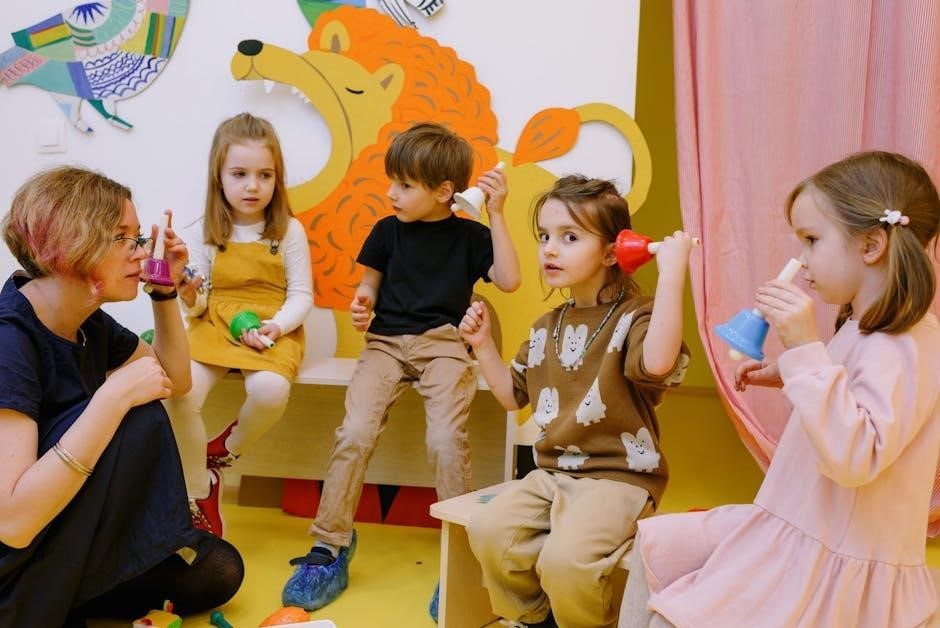
Inclusive Education Strategies
Inclusive education strategies focus on creating a supportive environment where all students, including those with special needs, can thrive. Collaboration, differentiated instruction, and accessible resources are key.
3.1 Creating an Inclusive Classroom Environment
Creating an inclusive classroom environment involves fostering respect, empathy, and collaboration among all students. Teachers can achieve this by rearranging physical spaces to promote accessibility and interaction. Incorporating diverse educational materials that reflect students’ cultures and experiences is essential. Additionally, fostering a growth mindset and encouraging peer mentoring can help students with special needs feel valued. Flexible seating arrangements and sensory-friendly spaces also support inclusivity. Teachers should model inclusive behaviors and address any biases or stereotypes. By creating a safe and accepting atmosphere, educators ensure that all students, regardless of their abilities, can participate fully and feel a sense of belonging.
3.2 Whole-Class Teaching Strategies for SEN
Whole-class teaching strategies for SEN involve approaches that cater to diverse learning needs while engaging all students. Differentiated instruction is key, allowing teachers to tailor lessons to individual abilities. Using visual aids, structured routines, and movement activities helps SEN students stay focused. Incorporating scaffolding techniques, such as breaking tasks into smaller steps, supports understanding. Pre-teaching vocabulary and concepts ensures accessibility for all learners. Assessing student progress through formative methods helps identify additional support needs. By integrating technology and hands-on activities, teachers create engaging and inclusive lessons that address the varied needs of the entire class, fostering a supportive and effective learning environment.
3.3 Differentiated Instruction Techniques
Differentiated instruction techniques involve tailoring teaching methods to meet the diverse needs of special needs students. Strategies include learning centers, tiered assignments, and flexible grouping, allowing students to engage with content at their own pace and ability level. Scaffolding techniques provide temporary support to build independence, while formative assessments help monitor progress and adjust instruction. Incorporating technology, such as assistive devices, and hands-on activities enhances engagement. These techniques ensure that each student receives a personalized learning experience, fostering confidence and academic success. By addressing individual learning styles and abilities, differentiated instruction creates an inclusive and effective classroom environment for all students.

Behavioral Support and Management
Positive reinforcement, clear expectations, and consistent routines are essential for effective behavioral support and management in special needs education settings. Proactive strategies and individualized behavior plans help manage and support students effectively in special needs settings.
4.1 Positive Behavioral Interventions and Supports (PBIS)
Positive Behavioral Interventions and Supports (PBIS) focus on creating a supportive environment by reinforcing positive behaviors and reducing challenging ones. This approach emphasizes proactive strategies like clear expectations, consistent routines, and positive reinforcement. By identifying triggers and teaching alternative behaviors, PBIS helps students develop self-regulation skills. Data collection and analysis are key components, ensuring interventions are tailored to individual needs. PBIS fosters a culture of respect, inclusivity, and academic engagement, benefiting all students and staff. It is widely recognized as an effective framework for addressing behavioral needs in special education settings, promoting long-term social and emotional growth.
4.2 Strategies for Managing Challenging Behaviors
Managing challenging behaviors in special needs students requires a combination of proactive and reactive strategies. Functional Behavior Assessments (FBAs) help identify triggers and underlying causes of behavior, enabling tailored interventions. Strategies such as de-escalation techniques, visual supports (e.g., behavior charts), and positive reinforcement can reduce disruptions. Breaking tasks into smaller steps and providing choices empower students, fostering autonomy. Non-verbal cues and redirection techniques can also minimize escalations. Consistency, patience, and collaboration with support staff are crucial. By addressing root causes and teaching alternative behaviors, educators create a calm and productive learning environment, promoting social and emotional growth for all students.
4.3 Incorporating Sensory Integration Techniques
Incorporating sensory integration techniques into special needs education helps students regulate sensory experiences, enhancing focus and engagement. Strategies include providing fidget tools, weighted blankets, or tactile activities to address tactile sensitivities. Movement breaks, sensory bins, and visual timers can also support self-regulation. Teachers can create sensory-friendly environments by adjusting lighting, noise levels, and seating arrangements. Collaborating with occupational therapists ensures tailored approaches for individual needs. These techniques not only improve sensory processing but also reduce anxiety and stress, fostering a more inclusive and supportive classroom atmosphere for students with diverse sensory requirements.

Collaborative Teaching and Support
Collaborative teaching involves teamwork among educators, support staff, and families to meet students’ diverse needs, ensuring cohesive and effective learning experiences through shared responsibilities and open communication.
5.1 Collaboration with Parents and Guardians
Collaboration with parents and guardians is essential for creating a cohesive support system for special needs students. Regular communication through meetings, progress reports, and informal discussions ensures alignment between home and school strategies. Parents provide valuable insights into their child’s strengths, challenges, and routines, enabling educators to tailor approaches effectively. Involving parents in decision-making processes fosters trust and shared responsibility, leading to better academic and behavioral outcomes. Additionally, educators can empower parents by sharing resources and techniques, helping them support their child’s learning at home. This partnership is critical for addressing diverse needs and promoting a collaborative, student-centered approach to education.
5.2 Working with Multidisciplinary Teams
Working with multidisciplinary teams is crucial for special needs education. These teams comprise professionals such as psychologists, speech therapists, and occupational therapists, each bringing unique expertise. Regular collaboration ensures a comprehensive approach to student support. Shared goal setting and consistent communication among team members help align strategies, benefiting the student’s overall development. This integrated effort fosters a supportive learning environment tailored to individual needs, enhancing academic and personal growth effectively.
5.3 Role of Support Staff in SEN Education
Support staff play a vital role in special needs education by providing direct assistance to students, teachers, and other professionals. They help with daily tasks, behavioral support, and implementing individualized plans. Support staff often work closely with teachers to adapt resources and activities, ensuring students with SEN can fully participate. Their contributions enhance the overall learning experience, fostering an inclusive and supportive environment. Effective collaboration between teachers and support staff is essential for meeting diverse student needs and promoting their academic and personal development.

Technology Integration in Special Needs Education
Technology integration enhances learning for special needs students by providing assistive tools, personalized resources, and interactive platforms that cater to diverse abilities and promote engagement;
6.1 Assistive Technology for Learning Disabilities
Assistive technology (AT) provides tailored support for students with learning disabilities, enhancing their academic and personal development. Tools like text-to-speech, speech-to-text, and screen readers help students with dyslexia or visual impairments. Interactive software supports math and reading skills for those with dyscalculia or dyslexia. These technologies enable personalized learning, fostering independence and confidence. By addressing specific challenges, AT ensures students can access curriculum materials effectively. Regular updates and training are essential to maximize the benefits of these tools, creating an inclusive and supportive learning environment.
6.2 Using Multimedia Resources for Engagement
Multimedia resources, such as videos, interactive simulations, and educational games, are powerful tools for engaging special needs students. These resources cater to diverse learning styles, making complex concepts more accessible. For students with visual or auditory learning preferences, multimedia enhances comprehension and retention. Interactive elements encourage active participation, boosting motivation and focus. Additionally, multimedia can be adapted to individual learning needs, providing a personalized experience. Regular integration of multimedia in lessons fosters a dynamic and inclusive classroom environment, ensuring all students, regardless of their abilities, can connect with the material and achieve their learning goals effectively.
6.3 Gamification and Interactive Learning Tools
Gamification and interactive learning tools are innovative strategies that enhance engagement for special needs students. By incorporating game-like elements such as points, badges, and leaderboards, educators can tap into students’ natural motivation to play and compete. Interactive tools, like educational apps and virtual simulations, allow students to actively participate in learning; These tools often provide immediate feedback, helping students track progress and build confidence. Gamification also fosters a sense of achievement, which is particularly beneficial for students who may struggle with traditional teaching methods. By integrating these tools, educators create a dynamic and engaging learning environment tailored to diverse abilities and needs.
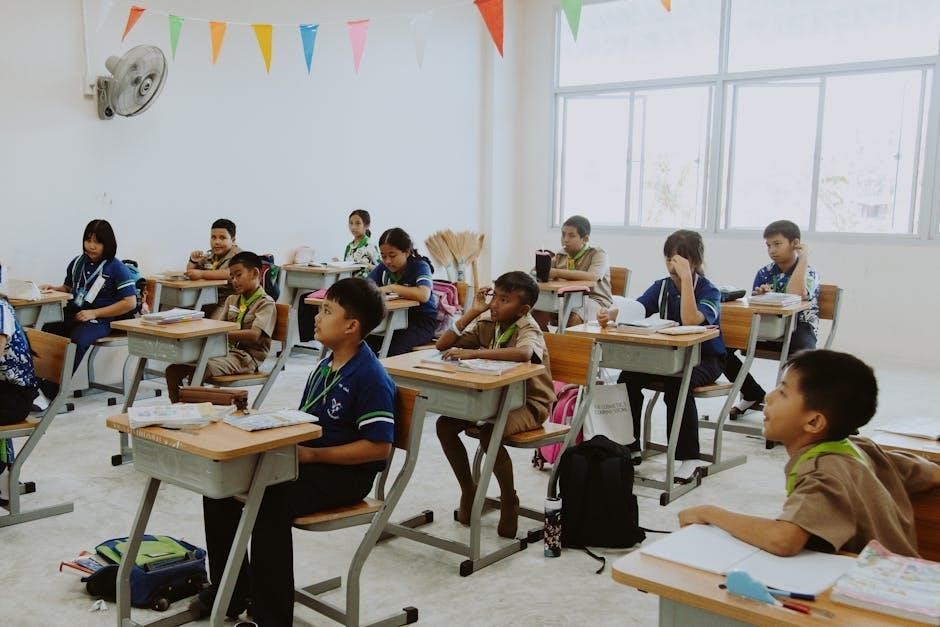
Skill Development for Special Needs Students
Skill development for special needs students focuses on building independence, confidence, and essential life abilities. A supportive environment with tailored strategies fosters growth and achievement.
7.1 Teaching Life Skills and Independence
Teaching life skills and independence is crucial for special needs students to thrive in daily life. Strategies include incorporating practical activities, such as daily living tasks, into lesson plans. Assessing individual needs and setting realistic goals helps tailor instruction. Techniques like task analysis and positive reinforcement encourage mastery of skills. Creating a supportive environment fosters confidence and self-reliance. Collaborating with parents and guardians ensures consistency in skill development. By focusing on independence, educators empower students to manage personal care, navigate social situations, and develop problem-solving abilities, laying the foundation for long-term success and self-esteem.
7.2 Enhancing Communication and Social Skills
Enhancing communication and social skills is vital for special needs students to interact effectively with peers and adults. Strategies include speech and language therapy, role-playing activities, and the use of visual aids like Picture Exchange Communication Systems (PECS). Group activities and peer mentoring foster social interactions and empathy. Teaching active listening, turn-taking, and problem-solving skills helps build relationships. Incorporating social stories and behavior scripts prepares students for real-life situations. Positive reinforcement and consistent feedback encourage progress. By addressing individual communication needs and promoting social competence, educators help students navigate social environments confidently and develop lasting interpersonal skills.
7.3 Fostering Academic and Vocational Skills
Fostering academic and vocational skills empowers special needs students to achieve independence and future employment. Teachers use tailored strategies like breaking tasks into smaller steps, incorporating assistive technology, and providing hands-on learning experiences. Vocational training programs, such as internships or job simulations, help students develop practical skills. Collaboration with occupational therapists ensures alignment with career goals. Assessments identify strengths and interests, guiding personalized learning plans. By integrating academic concepts with real-world applications, educators prepare students for lifelong learning and workforce participation. This dual focus on academics and vocational training equips students with the confidence and capabilities needed for successful, self-sufficient lives.
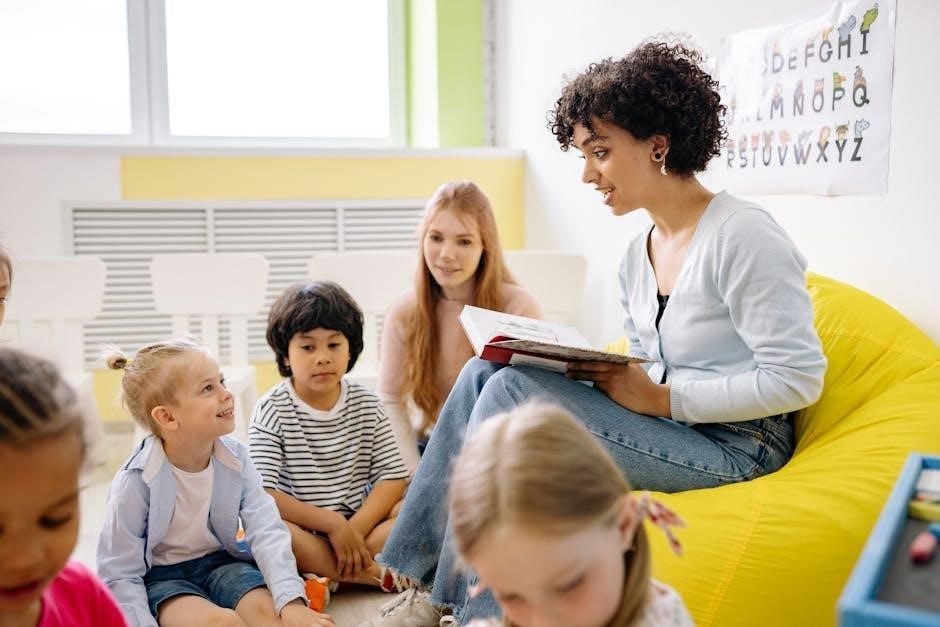
Cultural and Linguistic Considerations
Cultural and linguistic diversity must be embraced in special needs education. Teachers should adapt strategies to reflect students’ backgrounds, ensuring equitable access to learning. Training in culturally responsive practices and collaboration with families are essential to address unique needs effectively.
8.1 Addressing Cultural Diversity in SEN Education
Addressing cultural diversity in SEN education requires tailored strategies to meet the unique needs of students from diverse backgrounds. Educators must recognize and respect cultural differences, incorporating multicultural resources and practices. This includes adapting teaching materials to reflect students’ experiences and ensuring communication with families is culturally sensitive. Professional development for teachers on cultural awareness and bias reduction is crucial. Additionally, schools should foster collaboration with families from diverse backgrounds to create inclusive environments. By embracing cultural diversity, educators can ensure equitable opportunities for all students, regardless of their cultural or linguistic background, and promote a sense of belonging and acceptance.
8.2 Supporting Students with English as a Second Language
Supporting students with English as a second language (ESL) in special needs education requires tailored strategies to address language barriers. Teachers should use visual aids, simplified language, and bilingual resources to enhance understanding. Providing additional time for assignments and pairing students with peers who speak their native language can foster a supportive environment; Collaboration with ESL specialists ensures personalized language support. Incorporating students’ native languages in lessons can build confidence and bridge learning gaps. Regular progress monitoring and differentiated instruction are essential to meet their unique needs. This dual focus on language acquisition and special needs ensures equitable learning opportunities for all students.
8.3 Culturally Responsive Teaching Practices
Culturally responsive teaching practices are essential for creating an inclusive environment for special needs students from diverse backgrounds. Teachers should incorporate diverse cultural perspectives into lessons, ensuring materials reflect students’ experiences. Recognizing and respecting cultural differences helps build trust and engagement. Strategies include using culturally sensitive assessments, adapting teaching methods to align with students’ cultural values, and fostering open discussions about diversity. Encouraging collaboration among students from varied backgrounds promotes mutual understanding. By acknowledging and valuing each student’s cultural identity, educators create a supportive and inclusive learning space that enhances academic and social outcomes for all special needs students.
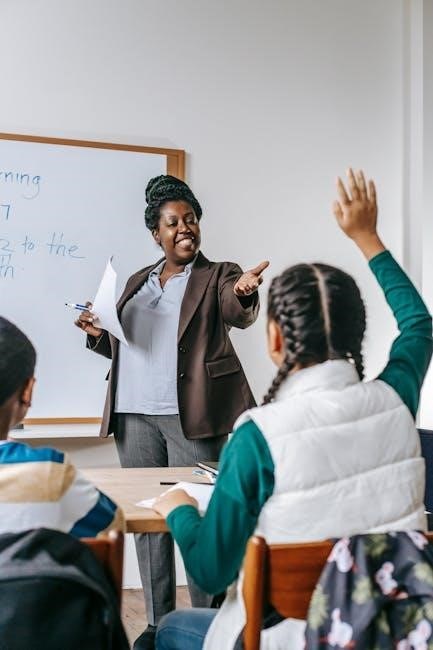
Continuous Professional Development
Continuous professional development is crucial for educators to enhance their skills in supporting special needs students. Ongoing training, workshops, and resources ensure teachers stay updated on best practices.
9.1 Teacher Training in SEN Strategies
Teacher training in Special Educational Needs (SEN) strategies is essential for effective support of students with diverse learning requirements. Training programs focus on understanding various disabilities, behavioral interventions, and differentiated instruction. Educators learn to create personalized learning plans, use assistive technologies, and implement inclusive practices. Professional development opportunities, such as workshops and online courses, help teachers stay updated on evidence-based methods. Continuous training ensures educators can address complex needs, foster inclusive classrooms, and promote academic and social growth for all students. Regular updates on SEN strategies empower teachers to adapt to evolving educational demands and improve student outcomes effectively.
9.2 Workshops and Resources for Educators
Workshops and resources for educators play a vital role in enhancing teaching strategies for special needs students. Professional development workshops provide hands-on training, allowing teachers to explore innovative methods and tools. Resources such as instructional guides, educational websites, and specialized software offer practical support. Many organizations provide downloadable materials, webinars, and online courses tailored for SEN educators. These resources often include lesson plans, assessment tools, and behavior management techniques. By leveraging these materials, educators can create engaging and inclusive learning environments. Accessibility to such resources ensures that teachers are well-equipped to meet the diverse needs of their students effectively and confidently.
9.3 Staying Updated with Best Practices
Staying updated with best practices in special needs education is essential for effective teaching. Educators can participate in professional associations, attend conferences, and engage in online forums to share knowledge. Subscribing to educational journals and newsletters ensures access to the latest research and strategies. Leveraging online platforms for continuous learning opportunities, such as webinars and workshops, helps educators stay informed. Collaborating with peers and experts fosters a culture of innovation and improvement. By actively seeking out new approaches and resources, teachers can refine their skills and deliver evidence-based practices tailored to their students’ unique needs, ensuring high-quality education.
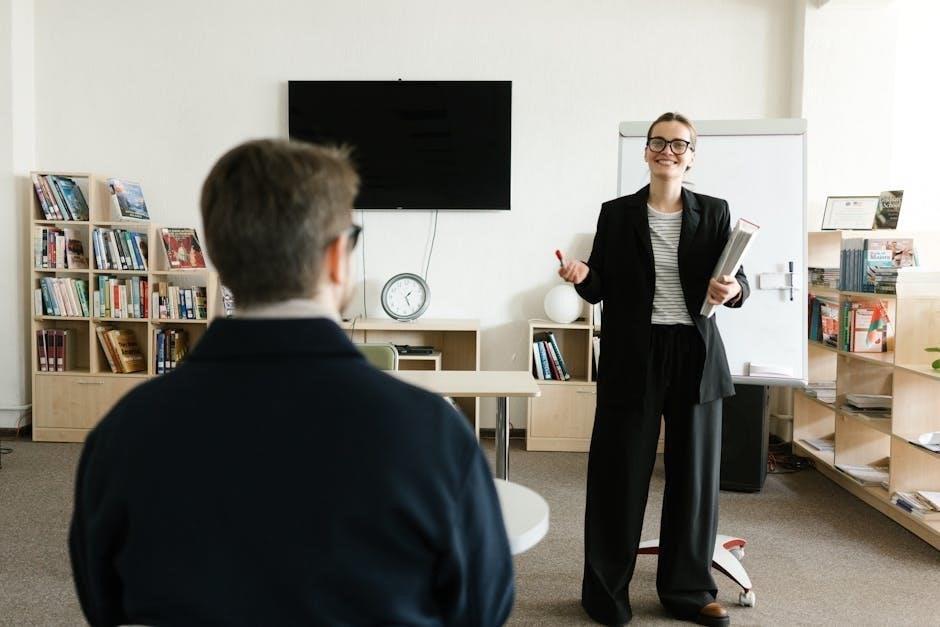
Monitoring and Evaluating Effectiveness
Regularly monitoring progress and evaluating teaching strategies ensures effectiveness. Data collection, feedback, and collaborative reviews help refine approaches, optimizing learning outcomes for special needs students.
10.1 Using Data to Drive Instruction
Using data to drive instruction is crucial for tailoring teaching strategies to meet the unique needs of special needs students. By regularly collecting and analyzing progress data, educators can identify areas of strength and areas requiring additional support. This data-driven approach allows for informed decision-making, ensuring interventions are targeted and effective. Formative assessments, progress monitoring tools, and performance metrics provide valuable insights, enabling teachers to adjust instruction in real-time. Data also helps track long-term goals outlined in Individualized Education Plans (IEPs), fostering accountability and continuous improvement. Leveraging data ensures that teaching strategies remain responsive, relevant, and aligned with student progress.
10.2 Evaluating the Impact of Teaching Strategies
Evaluating the impact of teaching strategies for special needs students involves assessing their effectiveness in meeting learning objectives and improving outcomes. This includes using formative and summative assessments to measure progress and identify gaps. Teachers can employ standardized tests, observational data, and student work samples to gauge effectiveness; Additionally, feedback from students, parents, and peers provides valuable insights. Regular evaluation ensures that strategies are aligned with Individualized Education Plans (IEPs) and promote meaningful growth. By systematically assessing the impact, educators can refine their approaches, ensuring that interventions are evidence-based and tailored to individual needs, ultimately enhancing the quality of special needs education.
10.3 Reflective Practices for Teachers
Reflective practices are essential for teachers working with special needs students, fostering professional growth and improved student outcomes. Teachers can engage in self-reflection through journaling, peer discussions, or mentoring. Reflecting on lesson effectiveness, student responses, and personal teaching strategies helps identify strengths and areas for improvement. Additionally, incorporating feedback from colleagues and students enhances teaching practices. Regular reflection ensures that educators remain adaptable, responsive, and aligned with student needs. By prioritizing reflection, teachers can refine their approaches, celebrate successes, and address challenges, ultimately creating a more inclusive and effective learning environment for special needs students.